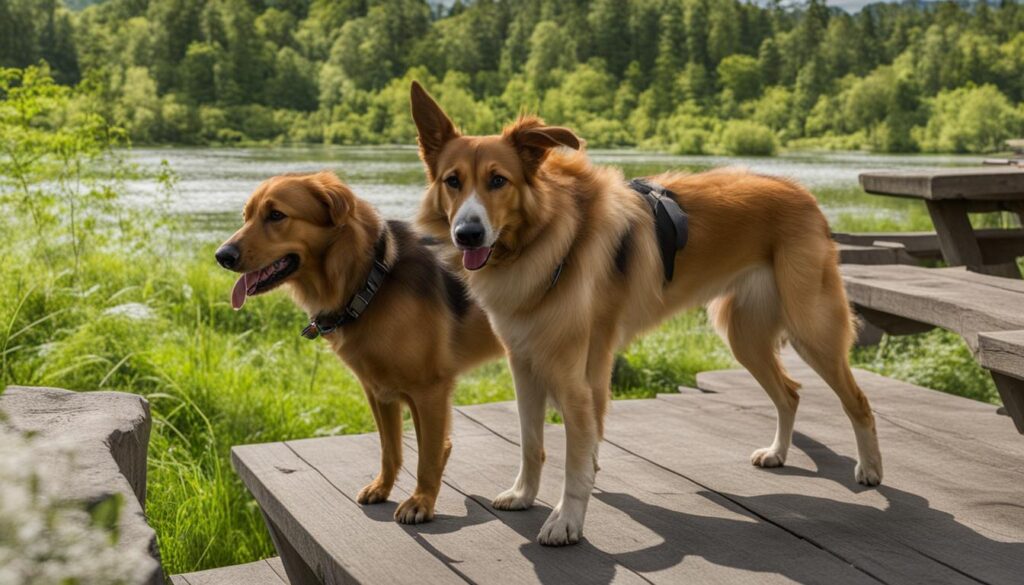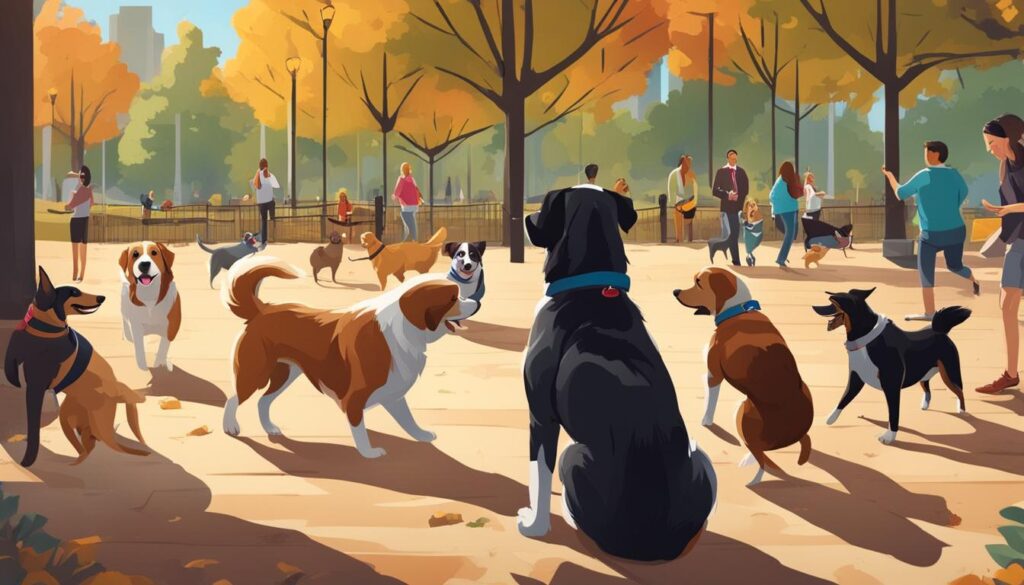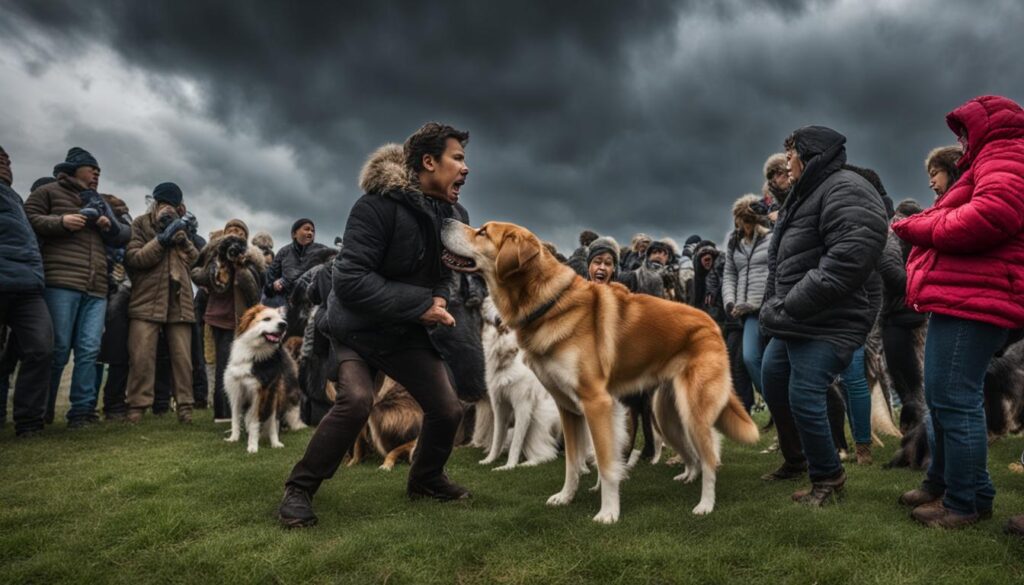The Impact of Social Settings on Your Dog’s Health: Understanding Risks and Precautions
Social settings play a significant role in the overall health and well-being of dogs. Interactions with other dogs, animals, and people can have both positive and negative effects on a dog’s health. Understanding the risks and taking necessary precautions is crucial for ensuring the safety and well-being of your furry friend. This article will explore the impact of social settings on a dog’s health, including the various health risks associated with social environments and the precautions that can be taken to prevent disease transmission.
Key Takeaways:
- Dog socialization is crucial for their overall well-being and behavior.
- Social environments expose dogs to potential health risks and disease transmission.
- Understanding the risks and taking necessary precautions is essential for protecting your dog’s health.
- Proper dog training and behavior management can help ensure a safe and positive socialization experience.
- Vaccinations, hygiene practices, and regular check-ups are essential in preventing disease transmission in dogs.
Dog Socialization and Its Significance in Canine Welfare
Socialization is an essential aspect of raising a well-adjusted and behaviorally healthy dog. It plays a crucial role in shaping a dog’s behavior and temperament, ultimately contributing to their overall welfare. Early puppy socialization is particularly important in establishing a solid foundation for a dog’s long-term social development.
The Role of Early Puppy Socialization
Early puppy socialization refers to the process of exposing puppies to a variety of positive experiences and environments during their critical developmental period. It typically begins at around 3 weeks of age and continues until they reach 14 weeks. This period is known as the socialization window, and it is a crucial time for optimal social development in puppies.
Puppy socialization involves gradually introducing them to different people, animals, and environments. The goal is to provide them with positive and safe experiences that help them become confident, well-rounded, and socially adept dogs.
During early puppy socialization, it is important to focus on positive reinforcement and gentle handling. Exposing puppies to a wide range of sights, sounds, smells, and textures helps them become accustomed to new stimuli and reduces the likelihood of fear, anxiety, and aggression later in life.
Maximizing the Socialization Window: 3-14 Weeks
The socialization window, which occurs between 3 to 14 weeks of age, is a critical period for puppies. It is during this time that they are most receptive to learning and forming positive associations. Maximizing the socialization window involves providing puppies with a rich and diverse range of experiences to help them develop into confident and well-behaved adults.
Here are some ways to maximize the socialization window:
- Introducing puppies to different types of people, including children, men, women, and individuals wearing hats, glasses, or uniforms.
- Exposing puppies to various animals, such as other dogs, cats, and small mammals, in controlled and safe environments.
- Gradually acclimating puppies to different environments, such as parks, streets, car rides, and indoor spaces.
- Providing positive and rewarding experiences during social interactions, such as play sessions, training exercises, and gentle handling.
- Ensuring puppies have opportunities to explore different surfaces, textures, sounds, and smells.
By maximizing the socialization window and providing puppies with positive and diverse experiences, we can significantly contribute to their overall well-being, behavior, and adaptability in social settings.

Common Health Risks in Social Environments for Dogs
Dogs are cherished members of our families, and their health and well-being are of utmost importance. When it comes to social environments, there are several health risks that dog owners should be aware of and take precautions against. In this section, we will explore three common health risks that dogs may encounter in social settings: canine distemper and canine influenza, understanding canine parvovirus, and the threat posed by external parasites such as ticks, fleas, and mites.
Canine Distemper and Canine Influenza
Canine distemper and canine influenza are contagious viral diseases that can be easily transmitted between dogs. Canine distemper is caused by the canine distemper virus (CDV) and affects various body systems, leading to symptoms such as fever, coughing, nasal discharge, and neurological signs. Canine influenza, caused by the influenza A virus (H3N8 and H3N2 strains), presents with flu-like symptoms such as coughing, sneezing, nasal discharge, and lethargy.
“Prevention is key in protecting your dog from these highly contagious diseases. Ensure your dog is up to date on vaccinations, especially for distemper and influenza, and avoid exposing them to dogs showing signs of illness.”
Understanding Canine Parvovirus
Canine parvovirus is a highly contagious viral disease that primarily affects puppies and unvaccinated dogs. It can cause severe gastrointestinal symptoms such as vomiting, diarrhea (often bloody), and dehydration. Parvovirus can survive in the environment for an extended period, making it essential to keep your dog away from contaminated areas and practice good hygiene.
External Parasites: Ticks, Fleas, and Mites
External parasites pose a threat to dogs in social environments. Ticks can transmit diseases such as Lyme disease and Rocky Mountain spotted fever, while fleas can cause discomfort, skin allergies, and transmit parasites like tapeworms. Mites, such as Sarcoptes and Demodex mites, can lead to skin conditions like mange. Regular parasite prevention measures, such as topical treatments and routine grooming, are essential in safeguarding your dog’s health.
To learn more about the impact of external parasites on dogs, take a look at the informative table below:

By understanding and taking necessary precautions against these common health risks, dog owners can ensure the well-being and safety of their furry companions in social environments.
The Hidden Dangers of Disease Transmission
Disease transmission is a hidden danger in social environments for dogs. Understanding the risks of disease transmission is crucial for preventing the spread of contagious diseases and protecting both dogs and their owners.
Certain diseases can be easily transmitted from dog to dog, and some diseases can even be transmitted from dogs to humans, known as zoonotic diseases. These contagious diseases pose a significant threat to the health and well-being of both dogs and humans.
By being aware of the hidden dangers of disease transmission, dog owners can take proactive measures to keep their pets and themselves safe. It is essential to practice good hygiene and follow preventive measures to minimize the risk of disease transmission in social settings.
Protecting your dog from contagious diseases not only ensures their well-being but also helps in preventing the spread of these diseases to other dogs and humans. By taking appropriate precautions, such as regular veterinary check-ups, vaccinations, and maintaining a clean environment, you can help keep your beloved pet and your family healthy and safe.
Dog Socialization, Health Risks, Disease Transmission, Precautions
The socialization of dogs brings both benefits and risks to their health. While socialization is essential for their overall well-being and behavior, it also exposes them to potential health risks and disease transmission. It is important to prioritize the health and safety of dogs in social environments by taking necessary precautions and preventive measures.
One of the key benefits of dog socialization is its positive impact on their behavior and temperament. When dogs are properly socialized, they are more likely to exhibit friendly and confident behavior, making them better equipped to handle various social situations. Socialization also helps dogs develop strong communication skills, allowing them to interact effectively with humans and other animals.

However, it is crucial to be aware of the potential health risks associated with dog socialization. In social environments, dogs can come into contact with contagious diseases and parasites, putting their health at risk. Common diseases that can be transmitted between dogs include canine distemper, canine influenza, and canine parvovirus. Additionally, external parasites such as ticks, fleas, and mites can also be easily transmitted in social settings.
To prevent disease transmission and ensure the well-being of dogs in social environments, there are several precautions that can be taken:
- Vaccinations: Keeping your dog up to date on vaccinations is essential for protecting them against contagious diseases. Consult with your veterinarian to establish a proper vaccination schedule for your dog.
- Hygiene practices: Practicing good hygiene is crucial in preventing disease transmission. Regularly disinfecting your dog’s belongings, such as toys and bedding, can help minimize the spread of germs.
- Regular check-ups: Schedule regular veterinary check-ups to ensure your dog is in good health and to detect any potential health issues early on.
By following these precautions, dog owners can minimize the risks associated with socialization and provide a safe and healthy environment for their furry friends. Socialization allows dogs to experience the world, learn new things, and build positive relationships. With proper precautions and responsible socialization practices, dogs can thrive in social settings while staying healthy and happy.
Effective Dog Training and Behavior Management in Public Spaces
Proper dog training and behavior management are essential for ensuring your dog’s well-being and safety in social environments. By teaching basic commands and obedience training, you can maintain control over your dog in public spaces and promote positive interactions with other dogs and people.
Basic Commands and Obedience
When training your dog, it is crucial to start with basic commands. These commands establish a foundation of communication between you and your dog, allowing for better control and management in public settings. Common basic commands include:
- Sit: Teach your dog to sit on command, which can help prevent jumping on people or running away.
- Stay: Train your dog to stay in one place until you give them permission to move, ensuring their safety in busy environments.
- Come: Teach your dog to come to you when called, promoting better recall and preventing them from approaching potentially dangerous situations.
- Leave it: Train your dog to ignore or let go of items they may encounter in public spaces, such as dropped food or unfamiliar objects.
- Heel: Teach your dog to walk calmly by your side, preventing pulling or lunging on the leash.
Consistency, positive reinforcement, and patience are key when teaching basic commands. Always reward your dog with praise, treats, or a toy for successfully following a command.
Coping with Aggression and Anxiety in Dogs
Aggression and anxiety issues can interfere with your dog’s ability to socialize effectively in public spaces. Addressing these issues is crucial for their well-being and the safety of others. Here are some strategies for coping with aggression and anxiety:
- Socialization: Gradually expose your dog to new people, dogs, and situations, using positive reinforcement techniques to build positive associations and reduce fear or aggression triggers.
- Professional Training: Consider enlisting the help of a certified dog trainer or behaviorist who specializes in aggression or anxiety management. They can provide tailored training programs to address your dog’s specific needs.
- Desensitization and Counterconditioning: Gradually expose your dog to situations that trigger aggression or anxiety, starting at a comfortable distance and rewarding calm behavior.
- Avoid Triggers: Identify and avoid situations or environments that provoke aggression or anxiety in your dog whenever possible. This may include steering clear of crowded places or keeping distance from certain types of dogs or people.
- Provide a Safe Space: Create a designated safe space at home where your dog can retreat when feeling anxious. This could be a crate, a quiet room, or a designated corner with their bed and toys.

Resources and Further Training
If you are struggling with dog training, aggression, or anxiety issues, consider seeking professional assistance. They can provide tailored guidance and expertise to address your dog’s specific needs. Additionally, numerous books, online courses, and resources are available to help you better understand dog behavior and improve your training techniques.
Preventing Disease Transmission in Dogs: Best Practices
Vaccinations: Your First Line of Defense
One of the most effective ways to protect your dog from contagious diseases is through proper vaccinations. Vaccines stimulate the immune system to develop immunity against specific diseases, preventing your dog from becoming infected and reducing the risk of transmission to other dogs.
Consult with your veterinarian to determine the appropriate vaccine schedule for your dog based on factors such as age, lifestyle, and risk of exposure. Core vaccines, which are recommended for all dogs, protect against common and potentially life-threatening diseases such as distemper, parvovirus, and rabies. Non-core vaccines should be considered based on your dog’s individual needs and risk factors.
Hygiene and Health: Disinfecting and Regular Check-Ups
In addition to vaccinations, practicing good hygiene and ensuring regular veterinary check-ups are essential for preventing disease transmission in dogs. Regularly disinfecting your dog’s living environment, including their bedding, toys, and food and water bowls, can help eliminate potential sources of infection.
Maintaining a clean and hygienic living space for your dog is particularly important in social settings where multiple dogs interact. Regularly cleaning and disinfecting communal areas, such as dog parks and boarding facilities, can help minimize the risk of disease transmission among dogs.
Furthermore, scheduling regular check-ups with your veterinarian allows for early detection and treatment of any underlying health issues. Routine examinations, vaccinations, and screenings can help keep your dog in optimal health and reduce the risk of transmitting diseases to other dogs.
By following these best practices, you can help protect your dog and contribute to the overall health and well-being of the canine community.
Puppy Socialization: Balancing Exposure with Safety
Socializing puppies is a crucial part of their development, helping them grow into confident and well-adjusted adult dogs. However, it’s important to find the right balance between exposing them to new experiences and ensuring their safety and well-being. In this section, we will discuss the importance of safe socialization, including finding appropriate places for social experiences and understanding your puppy’s comfort levels.
Safe Places for Social Experiences
When socializing puppies, it’s essential to choose safe environments where they can interact with other dogs and people without unnecessary risks. Look for places that are clean, well-maintained, and have a controlled and supervised setting. Dog parks and puppy socialization classes are great options as they provide controlled interactions and opportunities for positive social experiences.
Reading Your Puppy’s Comfort Levels
Each puppy has its own comfort levels when it comes to socialization. It’s crucial to read your puppy’s body language and behavior to ensure they feel safe and secure during social experiences. Signs of stress or discomfort may include excessive panting, cowering, hiding, or growling. If you notice any signs of stress, it’s important to remove your puppy from the situation and provide them with a calm and familiar environment.
Remember: Puppy socialization should be a positive and enjoyable experience for them. It’s better to gradually expose them to new situations, ensuring they are comfortable and confident, rather than overwhelming them with too much too soon.
| Benefits of Safe Socialization | Risks of Inadequate Socialization |
|---|---|
|
|
Conclusion
In conclusion, dog socialization is crucial for the overall well-being and behavior of our furry friends. However, it’s important to recognize that socialization also comes with potential health risks and the possibility of disease transmission. But by understanding these risks and taking necessary precautions, we can create a safe and positive socialization experience for our dogs.
To prioritize your dog’s health, it’s essential to practice good hygiene. Regularly disinfecting their belongings and ensuring they have regular veterinary check-ups can go a long way in preventing the spread of diseases. Additionally, keeping vaccinations up to date is a vital first line of defense against contagious illnesses.
Being aware of potential disease transmission in social environments and actively mitigating those risks is essential. By being responsible pet owners and practicing responsible socialization strategies, dogs can thrive in social settings while staying healthy and happy. Together, we can create a supportive and safe environment for our furry companions to socialize, ensuring their overall well-being and a brighter future for dog socialization.
FAQ
What is the significance of dog socialization?
Dog socialization is essential for their overall well-being and behavior. It helps shape their behavior and temperament, making them well-adjusted and confident adults.
When is the critical period for puppy socialization?
The critical socialization window for puppies occurs between 3 to 14 weeks of age.
What are some common health risks in social environments for dogs?
Common health risks include canine distemper, canine influenza, canine parvovirus, and external parasites such as ticks, fleas, and mites.
Can diseases be easily transmitted between dogs?
Yes, certain diseases can be easily transmitted from dog to dog, posing a risk to their health.
Can dogs transmit diseases to humans?
Yes, some diseases can be zoonotic, meaning they can be transmitted from dogs to humans.
How can we prevent disease transmission in dogs?
Preventing disease transmission can be achieved through vaccinations, good hygiene practices, and regular veterinary check-ups.
What are some effective training techniques for dogs in public spaces?
Teaching basic commands and obedience training are effective for maintaining control over dogs in public spaces.
How can aggression and anxiety be addressed in dogs?
Aggression and anxiety issues in dogs can be addressed through proper training, behavior modification techniques, and professional guidance.
What precautions should be taken to ensure a safe socialization experience for puppies?
Choosing safe places for social experiences and reading a puppy’s comfort levels are important precautions to ensure their safety and well-being during socialization.

